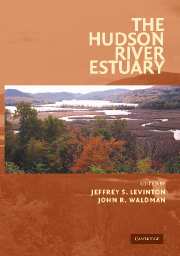Book contents
- Frontmatter
- Contents
- Preface
- List of Contributors
- The Hudson River Estuary
- 1 The Hudson River Estuary: Executive Summary
- GEOLOGICAL, PHYSICAL, AND CHEMICAL SETTING OF THE HUDSON
- PRIMARY PRODUCTION, MICROBIAL DYNAMICS, AND NUTRIENT DYNAMICS OF THE HUDSON
- HUDSON RIVER COMMUNITIES, FOOD WEBS, AND FISHERIES
- CONTAMINANTS AND MANAGEMENT ISSUES OF THE HUDSON RIVER ESTUARY
- 22 The History and Science of Managing the Hudson River
- 23 Hudson River Sewage Inputs and Impacts: Past and Present
- 24 PCBs in the Upper and Tidal Freshwater Hudson River Estuary: The Science behind the Dredging Controversy
- 25 Transport, Fate, and Bioaccumulation of PCBs in the Lower Hudson River
- 26 Contaminant Chronologies from Hudson River Sedimentary Records
- 27 Atmospheric Deposition of PCBs and PAHs to the New York/New Jersey Harbor Estuary
- 28 Toxic Substances and Their Impact on Human Health in the Hudson River Watershed
- 29 Impacts of Piers on Juvenile Fishes in the Lower Hudson River
- 30 Physiological and Genetic Aspects of Toxicity in Hudson River Species
- Index
- Plate section
- References
24 - PCBs in the Upper and Tidal Freshwater Hudson River Estuary: The Science behind the Dredging Controversy
Published online by Cambridge University Press: 06 January 2010
- Frontmatter
- Contents
- Preface
- List of Contributors
- The Hudson River Estuary
- 1 The Hudson River Estuary: Executive Summary
- GEOLOGICAL, PHYSICAL, AND CHEMICAL SETTING OF THE HUDSON
- PRIMARY PRODUCTION, MICROBIAL DYNAMICS, AND NUTRIENT DYNAMICS OF THE HUDSON
- HUDSON RIVER COMMUNITIES, FOOD WEBS, AND FISHERIES
- CONTAMINANTS AND MANAGEMENT ISSUES OF THE HUDSON RIVER ESTUARY
- 22 The History and Science of Managing the Hudson River
- 23 Hudson River Sewage Inputs and Impacts: Past and Present
- 24 PCBs in the Upper and Tidal Freshwater Hudson River Estuary: The Science behind the Dredging Controversy
- 25 Transport, Fate, and Bioaccumulation of PCBs in the Lower Hudson River
- 26 Contaminant Chronologies from Hudson River Sedimentary Records
- 27 Atmospheric Deposition of PCBs and PAHs to the New York/New Jersey Harbor Estuary
- 28 Toxic Substances and Their Impact on Human Health in the Hudson River Watershed
- 29 Impacts of Piers on Juvenile Fishes in the Lower Hudson River
- 30 Physiological and Genetic Aspects of Toxicity in Hudson River Species
- Index
- Plate section
- References
Summary
Introduction
From the latter 1940s until 1977, the General Electric Corporation (GE) discharged an estimated 200,000 to 1.3 million pounds (U.S. Environmental Protection Agency, 2000a) of polychlorinated biphenyls (PCBs) into the Hudson River from two electrical capacitor manufacturing plants at Hudson Falls and Fort Edward, New York (Fig. 24.1). In 1977, under a settlement agreement with the New York State Department of Environmental Conservation, GE stopped direct discharges of PCBs to the river, although leakage of PCBs from the factory sites to the river continues to this day. PCBs used at the GE plants were oily liquids containing dozens of distinct PCB compounds. Most of these components are persistent in the environment, attach strongly to soils and river sediments, and readily accumulate in fish, wildlife, and humans (National Research Council, 2001a). These properties, combined with the large discharges of PCBs from the GE plants over 50+ years, have led to elevated levels of PCBs in the water, sediments, and biota of the Upper Hudson River (defined here as the stretch upstream of the Troy lock and dam). Levels of PCBs in the Hudson River ecosystem are among the highest in the United States.
PCB contamination in the Hudson River is a management problem for the public because it has likely increased human health risks (primarily from consumption of fish), increased ecological risks to fish and fish-eating birds and mammals, and caused losses of river use and the resulting economic impacts (catch and release only fishery; advisories on fish consumption; restrictions on navigational dredging limiting access to the Champlain Canal; restrictions on and the increased costs of dredging; and commercial fishery closure).
- Type
- Chapter
- Information
- The Hudson River Estuary , pp. 349 - 367Publisher: Cambridge University PressPrint publication year: 2006
References
- 5
- Cited by



